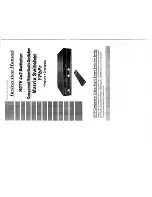
Provider backbone bridging through IEEE 802.1ad eliminates the need for tunneling BPDUs with L2PT and
increases the reliability of provider bridge networks as the network core need only learn the MAC addresses
of core switches, as opposed to all MAC addresses received from attached customer devices.
• Use the Provider Bridge Group address as the destination MAC address in BPDUs. The xstp keyword
applies this functionality to STP, RSTP, and MSTP; this functionality is not available for PVST+.
CONFIGURATION Mode
bpdu-destination-mac-address [xstp | gvrp] provider-bridge-group
Service Provider Bridging
968
Summary of Contents for S4048T
Page 1: ...Dell Configuration Guide for the S4048T ON System 9 10 0 1 ...
Page 98: ... saveenv 7 Reload the system uBoot mode reset Management 98 ...
Page 113: ...Total CFM Pkts 10303 CCM Pkts 0 LBM Pkts 0 LTM Pkts 3 LBR Pkts 0 LTR Pkts 0 802 1ag 113 ...
Page 411: ...mode transit no disable Force10 Resilient Ring Protocol FRRP 411 ...
Page 590: ...Figure 67 Inspecting the LAG Configuration Link Aggregation Control Protocol LACP 590 ...
Page 646: ...Figure 87 Configuring Interfaces for MSDP Multicast Source Discovery Protocol MSDP 646 ...
Page 647: ...Figure 88 Configuring OSPF and BGP for MSDP Multicast Source Discovery Protocol MSDP 647 ...
Page 653: ...Figure 91 MSDP Default Peer Scenario 2 Multicast Source Discovery Protocol MSDP 653 ...
Page 654: ...Figure 92 MSDP Default Peer Scenario 3 Multicast Source Discovery Protocol MSDP 654 ...
Page 955: ...Figure 119 Single and Double Tag First byte TPID Match Service Provider Bridging 955 ...
















































